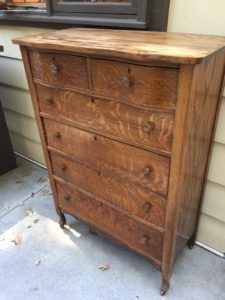 SS sent me a turn of the last century Golden Oak dresser, in Quarter Sawn Oak, with a serpentine front. It looks like a dresser but the drawers hardly slide anymore. She pulled it out of her house and planned to set it on the street with a FREE sign on it. Before she does, she wants to know if she should rethink her generosity. Have you noticed how many pieces of furniture and kitchen ware show up on our streets these days? People got sick of their homes and their décor! SS redid her interior out of shear boredom.
SS sent me a turn of the last century Golden Oak dresser, in Quarter Sawn Oak, with a serpentine front. It looks like a dresser but the drawers hardly slide anymore. She pulled it out of her house and planned to set it on the street with a FREE sign on it. Before she does, she wants to know if she should rethink her generosity. Have you noticed how many pieces of furniture and kitchen ware show up on our streets these days? People got sick of their homes and their décor! SS redid her interior out of shear boredom.
Golden Oak wasn’t only a type, cut and color of oak used for turn of the century furniture, but also the NAME of a type of furniture distinctive of true American style. In fact, some scholars call it the first true American style of furniture because of three features that make it different from European and English furniture styles.
Those features?
- The affordability and accessibility of the furniture designed to appeal to the growing American middle class
- The wood itself, American Oak
- The simple “American country” look of the style.
This last point bears explanation: The style is curvy and organic, as opposed to geometrical, which lends an air of quaintness and informality to the pieces. Notice the curved drawer fronts on SS’s piece.
Previous to the period, from about 1820-1880, American furniture borrowed styles popular in Europe and England.
The names of the periods tell this story:
- 1820 George Hepplewhite, a British designer, Empire (based on the French Empire style favored by Napoleon)
- followed by the whole period called Victorian, which itself became a series of European revival styles (Classical revival, French Revival, the Aesthetic Movement—based on the late Arts and Crafts style of England, and then Arts and Crafts itself
- then a distinctive non-Victorian style.
Golden Oak, a middle class popularist style, didn’t have an exotic origin. This style ran in tandem with a British style that made its way to America. Eastlake, after Charles Locke Eastlake (1833-1906) a British designer who eschewed the curving lines of the French Revival style and disliked the oppressiveness of the Victorian drawing rooms. Eastlake furniture was more intellectual and formal, because of its linear and massive design. Golden Oak was for the American People, and designed for smaller modest homes.
Not only did Golden Oak start a decorating craze, the woman of the house got to chose the pieces. This departured from the tastemakers who up till 1880 were men. The lines of the furniture were deigned with this market in mind. Advertisements, such as those in Sears and Roebuck catalogues, showed a cozy country style interior with floral patterns and lighter colors, and that curving Golden Oak style. Makers constructed it so that if Sears delivered it in pieces, almost anyone could put it together because of no dovetails, no drawer liners, just a case piece empty in the middle with sliders simply pegs of curved iron, on two to a drawer cross- member. The problem appeared after pulling the drawers twenty times. A heavy drawer carved grooves that rendered the drawer useless.
The Value of the Oak Dresser?
The problem is that everything that sells well now appears linear, and geomantic, mid century-ish. Golden Oak style is the exact opposite of linear and coldly geomantic, the opposite of understated elegance. Cute, yes. and the cut of the wood makes it even cuter. SS’s piece’s wood is quarter sawed oak. That means a round section of the log is cut in quarters and then shorter and shorter sections, so you see this mottled appearance of light and dark sections of the oak. This made inexpensive furniture look fancier. This is not exactly veneering, as that was an expensive technique, but mass-produced quarters of oak used to make figured wood surfaces.
In short, someone might pay you about $20 for that dresser, and they might offer less because those grooves in each of the under-drawer sections have ‘frozen’ the action of the drawer in place.
So, it might be fun to see how long it sits on the street, SS. Send me the timeline as it sits! I will anxiously wait to hear.